

Rendon, l. 1994 validation theory. 15 active learning activities to energize your next college class. The evidence just keeps growing – postsecondary students engage more, learn more and accomplish more with active learning.
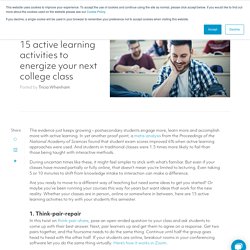
In yet another proof point, a meta-analysis from the Proceedings of the National Academy of Sciences found that student exam scores improved 6% when active learning approaches were used. And students in traditional classes were 1.5 times more likely to fail than those being taught with interactive methods. CollaborationtoolCSAT. Gender Issues in Collaborative Learning. Cooperative. Group work: Using cooperative learning groups effectively. How to start first day. The Difference Between Teaching and Telling by Adam Griffin on Prezi. Improving Classroom Performance by Challenging Student Misconceptions About Learning – Association for Psychological Science. In an overview of the preparedness of high school seniors for college level work, Kuh (2007) comes to conclusions familiar to many teachers.
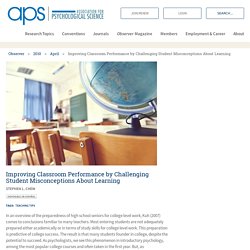
Most entering students are not adequately prepared either academically or in terms of study skills for college level work. This preparation is predictive of college success. The result is that many students founder in college, despite the potential to succeed. As psychologists, we see this phenomenon in introductory psychology, among the most popular college courses and often taken in the first year.
Effective groups handout. Austin Community College. Resource: A Private Universe. 1.
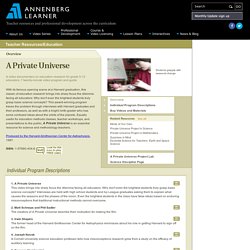
A Private Universe This video brings into sharp focus the dilemma facing all educators: Why don't even the brightest students truly grasp basic science concepts? Interviews are held with high school students and Ivy League graduates asking them to explain what causes the seasons and the phases of the moon. Even the brightest students in the class have false ideas based on enduring misconceptions that traditional instructional methods cannot overcome. 2. Characteristics of Millennial Students: What Professors Need to Know. The first indication that the Millennial Generation may be different from previous generations is to consider how many different names we have for the generation and the people who belong to it.

They’re referred to as Generation Y, Nexters, Baby Boom Echo Generation, Echo Boomers, Digital Natives, Generation Next, Generation Me and, of course, Millennials. If nothing else, they’re one of the most studied generations. Weimer%20ch.%204%20Student%20Feedback. Faculty Information - Student Ratings. Michael Theall, PhD Editor's note: Michael Theall has twenty-six years of experience as a faculty member and as a professional in instructional design, development, and evaluation.

He has founded faculty centers for teaching, learning, and evaluation at three universities: the University of Illinois, the University of Alabama, and Youngstown State University (OH). Theall and colleague Jennifer Franklin recently received a career achievement award from the American Education Research Association (AERA) for their work in faculty evaluation and development. Office of the Provost and Executive Vice President for Academic Affairs. Click here for Fall semester 2015 sign-up to have a SGID done in your class!

Why SGIDs? The Small Group Instructional Diagnosis was developed by Joseph Clark and Mark Redmond as a government grant project in 1982. The SGID is a mid-term course evaluation where a trained facilitator conducts a structured conversation with students to highlight the students’ consensus on what is going well and poorly in the class, what the instructor could do to further facilitate students learning, and what students could do to contribute to their own learning. RANDOM THOUGHTS - WHAT DO THEY KNOW, ANYWAY? Felder, Richard, "What Do They Know Anyway?

"Chem. Engr. Professor gives low rating to effectiveness of current teaching evaluations. In a paper released Friday, a UC Berkeley professor and a campus consultant found student course evaluations do not properly measure teaching effectiveness.

Philip Stark, chair and professor of statistics at UC Berkeley, and Richard Freishtat, a senior consultant in the Center for Teaching and Learning at UC Berkeley, examined the statistics behind student course evaluations and determined that because of the imperfect response rate and flawed averaging process, student evaluations should not be used to gauge teaching efficacy. “There is empirical support that student evaluations are, to some extent, reliable, repeatable,” Stark said. Student Evaluations Offer Bad Data That Leads to the Wrong Answer. Stuart Rojstaczer, a former professor of geology and civil engineering at Duke University, is the creator of of the Grade Inflation Web site.
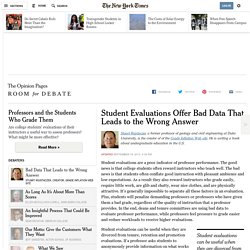
He is writing a book about undergraduate education in the U.S. Student evaluations are a poor indicator of professor performance. The good news is that college students often reward instructors who teach well. The bad news is that students often conflate good instruction with pleasant ambience and low expectations. As a result they also reward instructors who grade easily, require little work, are glib and chatty, wear nice clothes, and are physically attractive. 2009 05 Does%20Evaluating%20Instruction%20Improve%20It. Ks cashin student ratings of teaching. CATS Principles for Chair packets. Idea paper 50. Changing Practices in Faculty Evaluation.
Years ago, the process of faculty evaluation carried few or none of the sudden-death implications that characterize contemporary evaluation practices.
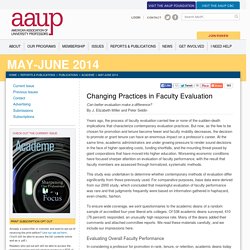
But now, as the few to be chosen for promotion and tenure become fewer and faculty mobility decreases, the decision to promote or grant tenure can have an enormous impact on a professor’s career. At the same time, academic administrators are under growing pressure to render sound decisions in the face of higher operating costs, funding shortfalls, and the mounting threat posed by giant corporations that have moved into higher education.
Worsening economic conditions have focused sharper attention on evaluation of faculty performance, with the result that faculty members are assessed through formalized, systematic methods. This study was undertaken to determine whether contemporary methods of evaluation differ significantly from those previously used. Evaluating Overall Faculty Performance. Student%20Course%20Evaluations. Student Evaluations: Feared, Loathed, and Not Going Anywhere. Janet Wilson has a number burned into her mind: 4.7. That’s the average student-evaluation score, on a five-point scale, that she has to reach to feel safe. Her score helps to determine her fate as a full-time, non-tenure-track professor at her West Coast research university.
“Everybody in my department is obsessed,” says Ms. Wilson, a teacher in the humanities for more than a decade. Trends in Student Ratings of Faculty on JSTOR. Educational Theory and Practice: Welcoming Student Feedback to Improve the Teaching Process. By Jackie Tran, Pharm.D., PGY1 Pharmacy Practice Resident, Howard County General Hospital Going through pharmacy school, the biggest thorn in my side was filling out those end of the course/rotation evaluation forms. These lengthy forms seemed to take ages to complete and with each instructor or preceptor came the same set of questions. Gathering and acting on feedback. Gathering your own Student Feedback 1. Quick & Easy Feedback Strategies 2. Student Group Interviews 3. Focus Group Interviews 4. Getting Feedback Online Peer observation of teaching and other collaborative activities 5. MMM%20how use student feedback improve teaching 20mm supplement. Student Evaluations: A Critical Review.
By Michael Huemer. What If Students Could Fire Their Professors? : NPR Ed. The Right Way to Use College Professor Ratings. The freedom you experience as a college student can be a shock after coming from the high school structure you were used to. Finally being able to choose your own schedule, courses, and professors is a great thing, only if done strategically. Selecting the right classes depends on what courses you need to complete your general ed and major requirements. The Power of an Effective Teacher and Why We Should Assess It. Methods for improving teaching using student feedback techniques. 1The teacher’s purpose is to teach and the students’ is to learn, but teachers can learn from students how to teach better.
WPI Teaching with Technology Collaboratory - Gathering Student Feedback. Getting and Using Student Feedback. Student Experience of Learning and Teaching (SELT) Schulich School of Business - Improving Teaching Using Student Feedback. Is it really necessary to discuss the feedback with the students? Yes. Student evaluations. Gathering Feedback from Students. Print Version. Feedback. 3 Ways of Getting Student Feedback to Improve Your Teaching. Improving Your Teaching: Obtaining Feedback. Using Student Feedback toImprove Teaching. Using Student Feedback. Vanderbilt University.